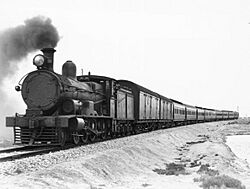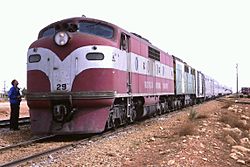Trans-Australian Railway facts for kids
Quick facts for kids Trans-Australian Railway |
|---|
The Trans-Australian Railway is a famous railway line in Australia. It opened in 1917 and connects Port Augusta in South Australia to Kalgoorlie in Western Australia. This railway crosses the huge, flat area known as the Nullarbor Plain.
This railway is super important for Australia's economy. It's the only rail line that carries goods between Western Australia and the eastern states. It also holds a world record: it has the longest section of perfectly straight track anywhere!
Today, two special passenger trains use parts of this line. The Indian Pacific travels the entire length of the railway. The Ghan uses the line between Port Augusta and Tarcoola before heading north to Darwin. Both trains offer amazing travel experiences.
Contents
Building the Trans-Australian Railway
Why the Railway Was Needed

In 1901, the six separate Australian colonies joined together to form the country we know today, the Commonwealth of Australia. Back then, Perth, the capital of Western Australia, was very far away from the other states. It was separated by thousands of kilometres of desert.
The only easy way to travel between Perth and the eastern states was by sea. But the journey across the Great Australian Bight was long, rough, and often uncomfortable. To convince Western Australia to join the new country, the government promised to build a railway line connecting it to the rest of Australia.
Planning and Starting Construction
In 1907, a law was passed to survey the route for the railway. This survey was finished in 1909. It suggested a path from Port Augusta (where a railway already ended) through Tarcoola to Kalgoorlie, a gold mining town in Western Australia. This distance was about 1,711 kilometres.
The new railway was planned to use a special track width called "standard gauge" (1,435 mm). This was different from the narrower tracks used by the state railways at each end of the line at the time. The estimated cost was about £4 million.
In December 1911, the Fisher government approved the railway's construction. Work officially began in September 1912 in Port Augusta.
Building Through the Desert
Construction continued from both ends – eastwards from Kalgoorlie and westwards from Port Augusta – even during the First World War. Workers laid tracks very quickly when they had enough materials. At its fastest, they could lay up to 4 kilometres of track each day! In one year, they completed 711 kilometres, which was an Australian record.
By 1915, the two ends of the line were just over 965 kilometres apart. Materials were delivered every day to keep the work going. The railway slowly stretched through dry and empty areas. Finally, the two halves of the line met at a place called Ooldea on October 17, 1917.
Early Operations and Challenges
After the railway was finished, the Commonwealth Railways company was created in 1917 to run the line. When passenger trains started, maintenance staff faced a big problem. The water found along the route had a lot of salt and minerals. This caused serious damage to the steam locomotive engines. At one point, fixing these engines made up 87% of all locomotive repairs! This problem was solved by adding special water treatment plants at the watering stops.
In 1937, the eastern end of the railway was extended 90 kilometres south to Port Pirie. Soon after, the South Australian Railways extended its wider track line 47 kilometres north to Port Pirie. These changes made the journey to Adelaide much shorter and more comfortable. They also removed one "break of gauge" (where passengers had to change trains because of different track widths). However, it made the Port Pirie Junction yard a complex place with three different track widths!
Connecting the Continent
The big goal of connecting Sydney and Perth with one standard track width was finally achieved in 1970. This meant trains could travel all the way across Australia without needing to change tracks.
In 2004, all the main state capitals in mainland Australia were finally connected by standard gauge tracks. This happened with a new connection between Port Pirie and Adelaide (and then Melbourne). Also, the northern part of the Adelaide–Darwin railway line was finished, which branches off the Trans-Australian Railway at Tarcoola.
In 2008, the railway's amazing engineering was recognized by Engineers Australia. Special markers were placed at the Port Augusta station and the Kalgoorlie station. On October 17, 2017, celebrations were held at Ooldea to mark 100 years since the railway was completed.
Famous Train Services
When the Trans-Australian Railway first opened, the passenger train was called the Great Western Express. Later, it became known as the Trans-Australian, or simply "The Trans."
After the entire route from Sydney to Perth was converted to standard gauge in 1970, a new train service started: the Indian Pacific. This meant passengers no longer had to switch trains at different places because of changing track widths. The Commonwealth Railways was in charge of the Indian Pacific on the Trans-Australian section.
In 1975, Commonwealth Railways became part of a larger government company called Australian National Railways. This company continued to operate the Trans Australian service. In 1993, Australian National took over the entire coast-to-coast service.
In 1997, Australian National was privatized (sold to a private company). The Indian Pacific was then sold to a company called Great Southern Rail (now "Journey Beyond"). As of 2020, the Indian Pacific is a weekly train that offers a special travel experience.
From the start of the railway until 1996, a special supply train called the Tea and Sugar ran along the route. It carried important supplies to the isolated work sites and towns along the line. It even had a butcher, banking services, and postal services on board!
The Unique Landscape
The Trans-Australian Railway is about 1,692 kilometres long. Even though it has many curves and slopes, it also has the longest straight section of track in the world! This amazing straight section is about 478 kilometres long.
An Australian astronaut named Andy Thomas once said that the line is so straight, you can see it from space! He described it as "a very fine line, it's like someone has drawn a very fine pencil line across the desert."
Along the entire route, the railway never crosses a permanent fresh water source. Water wells and reservoirs were built along the way, but the water was often salty and not good for the steam trains or for people to drink. So, trains had to carry their own water supplies. In the days of steam trains, about half of the train's total weight was just water for the engine! Later, special plants were built at major stations to turn salty water into usable water.
Names of Stopping Places
Many of the places along the Trans-Australian Railway were named after important people. Since the railway was owned by the Australian government, eight of these places were named after Australian Prime Ministers. Other important people also had places named after them, as you can see on the map.
How the Railway Operates
The original engineer, Henry Deane, knew it would be hard to find good water for steam trains in the desert. He thought about using diesel locomotives for the line, even though the technology was new at the time. However, he left his job before this idea could move forward.
At first, trains were pulled by steam locomotives. But from 1951, new diesel-electric locomotives were used for passenger services.
The railway originally had "crossing loops" (places where trains could pass each other) about every 100 kilometres. These loops were about 400 metres long. As more trains used the line, more loops were added. To handle longer trains, the loops were made longer. By 2008, all loops were at least 1,800 metres long and spaced about 30 to 60 kilometres apart.
Most crossing loops are not staffed. Train crews use radio controls to set the "turnouts" (the parts of the track that switch trains from one line to another) as they approach. This means they don't have to stop the train to switch tracks.
Railway Disruptions
Sometimes, the railway line has been affected by "washaways" and "flooding." These events usually remove the gravel (ballast) under the tracks, leaving the rails hanging in the air. This makes the railway unusable in those areas.
When washaways happen, the ballast needs to be replaced. Some major disruptions occurred in 1921, 1930, 1937, and 2022. During the 1930 flooding, two trains were stuck on different parts of the line.
Images for kids
See also
 In Spanish: Transaustraliano para niños
In Spanish: Transaustraliano para niños





